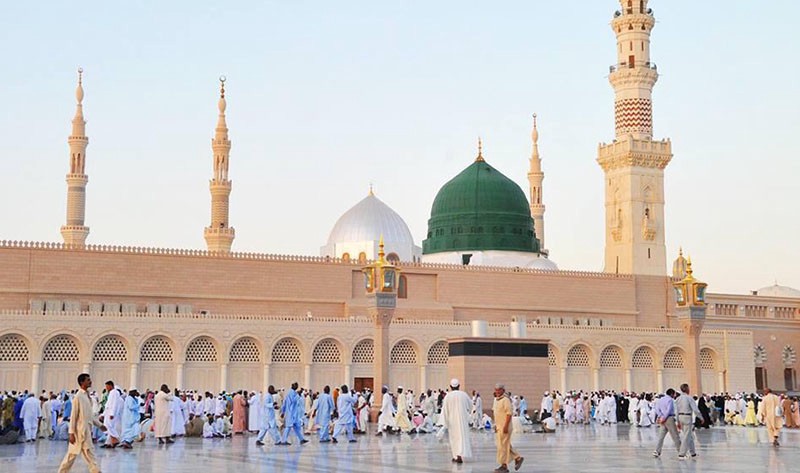If you wish to travel to a place known for its calmness and tranquility, then Madinah is a perfect destination. It is the second most important city to the Muslim world after Mecca. Madinah is the site of the mosque of the Prophet Mohammed bin Abdullah, peace be upon him, as well as his grave and the graves of his family and companions who spread the message of Islam.
Madinah is considered an oasis of serenity and peace, and offers a unique opportunity for worshiping, visiting religious monuments, relaxation and comfort, as well as visiting many places associated with the biography of the Prophet Muhammed, peace be upon him, and sites of Islamic history. The city is also rich in diverse cultural heritage and many archaeological and historical sites.
Prince Mohammed bin Abdulaziz International airport is the main artery of traveling in the region, as it serves more than two million passengers every year. Madinah is also linked with other cities and the rest of the provinces of the Kingdom through a network of highways.
Maindah is considered the regional capital and the administrative center of the region, and it includes a number of governorates:
• Yanbu: it is 250 kilometers away from Madinah, and is now the main marine port for the province Its port is used to export petroleum and petrochemical industries to most countries of the world.
• Badr: it is 150 kilometers away from Madinah. It is the place where one of the most significant Battles in Islamic history took place; the Badr Battle. The city also has Rayes Beach.
• Khaybar: it is 170 kilometers away from Madinah. It has forts, castles and water springs.Madinah includes other governorates such as Almahd, Alhnakyh, and Wadi Alfara’a, each of which has several unique historical landmarks.
Islamic History Sites
Visitors to Madinah are always keen on visiting the Holy Mosque of the Prophet Muhammad, peace be upon him, the Holy Rawdah and the Prophet Muhammad’s grave, peace be upon him. The visitor can then go to a number of sites that the Prophet had stepped foot in (Baqeea Al-Gharqad – Uhod Battle site – Quba Mosque). In addition, there are a number of sites with references in Islamic history, such as the site of the Battle of the Trench, Friday Mosque, Qiblatain Mosque, Ejabah Mosque, Ghamamah Mosque, Abu Bakr Mosque, Omar ibn al-Khattab Mosque, Ali bin Abi Talib Mosque, as well as Saqifat bani Sa’edah.
Hijaz Railway Station
Hijaz Railway Station is the biggest and last station on Hijaz railway. It consists of many buildings with a unique architectural style and maintenance workshops. The station will soon be a regional museum featuring many archeological artifacts.
Harrat Rahat
It is a unique geological park that includes many volcano craters and grooves left by the volcanic lava streams.
Faqrah
Faqrah is located in the high lands, which makes its climate moderate in summer and cold in winter. It is abundant in palm trees and honey apiaries, and it offers chalets and summer houses for daily or weekly rental. Faqrah is 30 kilometers away from the Fareesh Center, and it attracts an increasing number of visitors each year.
Entertainment and Shopping Centers
There are many shopping and entertainment centers in Madinah, namely: Aliah Mall, Noor Mall, Al-Rashid Mall and Al-Manar Mall. There are also a number of parks, such as King Fahad Park, Nakheel Park and Baydha Wild Park, in addition to several gardens and hiking and jogging places.
Museums
There are a number of museums in Madinah, including the Museum of the Holy Quran (King Abdulaziz Library), the Museum of Madinah in the Hijaz Railway Station, the Museum of Dar Madinah in the Knowledge Economics City, the Museum of Dinar and Dirham, Qimma Madinah Museum as well as the Media Museum.
Folklore
There is a variety of folkloric arts and poems for each occasion in Madinah. Some of them are in classical Arabic and others are colloquial accompanied by the rhythms of Alzeer, flutes and drums. Some examples are: Al-Khatib, Al-Mujeeb, Alhadi, Alkesrah, Almed’e, Alkhubaiti and Alsamiri.
Handicrafts
Madinah is famous for various handcrafts such as making silverware, pottery, and daily-use utensils. The agricultural environment in Madinah, especially that of palm trees, also developed the industry of wicker production, in which men and women compete to produce attractive and high quality products.
